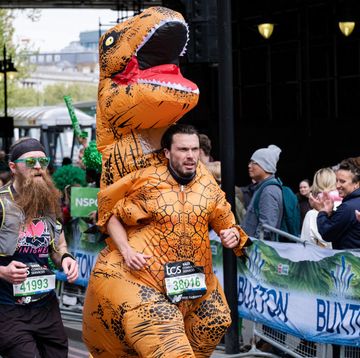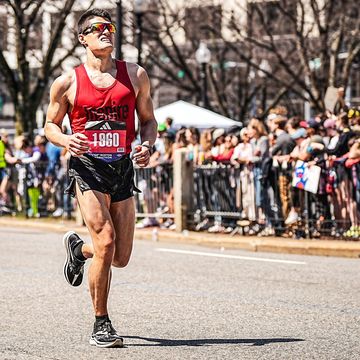The ways in which running helps you age successfully are legion—stronger heart and lungs, cleaner arteries, denser bones, improved mental health, less frailty, perhaps even better eyesight. To the list can now be added the seemingly obscure but important matter of spinal marrow tissue. Every six miles per week you run takes a year off the age of this crucial tissue, with implications for many facets of your health, according to new research out of Australia.
The study, published in the Journal of Bone and Mineral Research, looked at the spinal marrow adipose tissue (MAT) of four groups of people: runners averaging 12 to 25 miles per week, runners averaging at least 30 miles per week, cyclists averaging at least 90 miles per week, and sedentary folks. There were roughly 25 people in each group (101 total, including 54 women), and the subjects’ average age was 30. The key finding: The two groups of runners had the lowest levels of MAT, which is a desirable result. Despite being highly active, the cyclists had MAT levels similar to those of the sedentary group.
Why does this finding matter?
“Humans are born with predominately ‘red’ blood-cell-producing bone marrow,” says lead researcher Daniel Belavy, an associate professor at the Institute for Physical Activity and Nutrition at Deakin University in Victoria, Australia. “However, with age, this converts into a ‘yellow’ fatty marrow. This can negatively impact blood and bone metabolism in areas such as the pelvis, vertebrae, thighs and hips, and contribute to other chronic conditions, such as diabetes and osteoporosis.”
RELATED: Why Your Bones Need Weight-Bearing Activity
One ramification: Having more MAT means there’s less space in the marrow to produce red blood cells. Your amount of MAT is also believed to influence your other fat stores. Overall, Belavy says, think of marrow tissue as a type of regulatory organ that affects what happens throughout your body. As that marrow tissue becomes more fatty, those regulatory processes deteriorate. Belavy found that the marrow tissue of the most active runners (30 or more miles per week) was eight years “younger” than that of the sedentary subjects.
Belavy’s findings concerning adipose tissue aren’t just a matter of runners tending to be leaner than other people. “Marrow fat is governed by different rules than the fat stores under the skin” he says. “It is not just about burning calories.” After all, the study included cyclists who rode at least 90 miles per week, and they had similar amounts of marrow fat as sedentary people.
RELATED: Dr. Jordan Metzl tells how to keep your bones healthy.
The difference, Belavy believes, stems from the pounding of running. Cyclists “expend a lot of energy, but don’t load their spines in the same way runners do,” he says. “You also need the mechanical loading of the spine to impact on marrow fat.”
Although marrow tissue is part of bone, this study’s findings are distinct from those showing that weight-bearing exercise is good for bone health. “Bone is typically quantified by measuring its density,” Belavy says. “Bone is important structurally for support of the body and attachment of muscles. Marrow adipose tissue, on the other hand, has a number of regulatory roles: on blood cell production, on other fat stores, and, of course, on bone tissue. Increases in marrow adipose tissue negatively impact blood cell production and bone production.”
RW IN YOUR INBOX: Have the latest news, advice, and inspiration sent to you every day with our Runner’s World Newsletters.
The higher-mileage runners had the best MAT levels, but the most important distinction is between those who run and those who don’t. “We can be confident that even [12 miles of] running a week will have a beneficial impact on MAT,” Belavy says. “We can expect that less than that will also have an impact, but we still need to look at that.”
There’s currently no easy way to drop by your doctor’s office and have your MAT levels measured. But rest assured that, in this matter as with so many others, your run today sets you up for better health tomorrow.

Scott is a veteran running, fitness, and health journalist who has held senior editorial positions at Runner’s World and Running Times. Much of his writing translates sport science research and elite best practices into practical guidance for everyday athletes. He is the author or coauthor of several running books, including Running Is My Therapy, Advanced Marathoning, and Meb for Mortals. Scott has also written about running for Slate, The Atlantic, the Washington Post, and other members of the sedentary media. His lifetime running odometer is past 110,000 miles, but he’s as much in love as ever.













